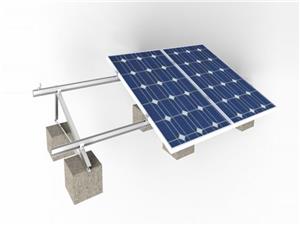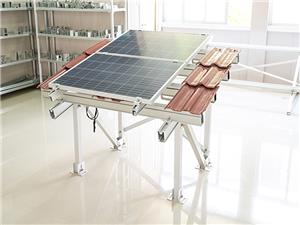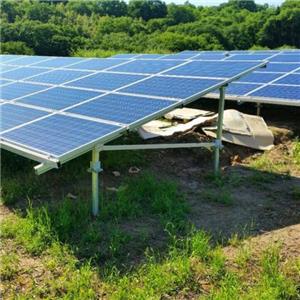How to install photovoltaic support in frozen soil area?
How to install photovoltaic support in frozen soil area?

The uneven frost heave and uplift of the photovoltaic support foundation is the focus and difficulty of the development and construction of photovoltaic projects in frozen soil areas. This article combines the design scheme of the solar panel support foundation of a photovoltaic project in the northeast area under frozen soil conditions, through the selection of the foundation type, the reduction of the tangential frost heave force of the foundation, and the design of the hoop-type adjustable height support. The research solved the problem of damage to photovoltaic modules caused by uneven frost heave and uplift of the support foundation, and put forward a set of basic feasible design schemes to prevent uneven frost heave and uplift of the photovoltaic support foundation in frozen soil areas.
Frozen soil areas generally have the following climatic and geological characteristics:
1) The temperature in winter is low, generally the lowest temperature is below -20 ℃;
2) The soil quality is strong frost heaving soil or extra strong frost heaving soil, such as clay, silty clay, etc.;
3) The groundwater is abundant and the water level is high. Under the conditions of abundant groundwater and high water level, it is difficult to construct independent concrete foundations, concrete pile foundations, and microporous cast-in-place pile foundations that require concrete pouring, and the winter temperature in frozen soil areas is extremely low. And the maintenance quality is difficult to guarantee. The concrete strip foundation is more suitable for areas with flat sites and low groundwater levels (such as deserts). In frozen soil areas, such foundations are prone to uneven uplift and tilt. The cost of spiral steel pipe pile foundation is relatively high, and it is not suitable for strong corrosive environment and fluid silt soil.
In summary, under the condition of frozen ground, considering the economy and convenience of construction, and taking the necessary reduction of pile length to prevent frost heave, the PHC foundation is a more suitable photovoltaic support foundation [2]. The following takes a photovoltaic project in Northeast China as an example to analyze the force of the PHC foundation under frozen soil conditions, and measures to prevent uneven frost heave and uplift.
2 Force analysis of PHC foundation under frozen soil conditions
Under the action of frost heave, the PHC foundation mainly bears permanent loads in the pile length direction (the weight of the upper bracket of the PHC, the weight of the components and the weight of the PHC, etc.), the tangential frost heave force of the frozen soil on the PHC, and the soil below the frozen soil layer on the PHC The anchoring force. From the perspective of stress analysis, it is uneconomical to rely solely on PHC anchoring to avoid uneven frost heave uplift when the maximum frost depth is deep in areas with strong frost heave soil or extremely strong frost heave soil.
According to the geological survey report, the standard frost depth for a photovoltaic project in Northeast China is 2.0 m. Within the standard frost depth range, the soil layers are surface cultivated soil, clay, and silty clay from top to bottom, all of which are strong frost heaves. Soil or extra-strong frost heaving soil; the groundwater level at the project site is -1.0 ~ -0.5 m. The project initially selected PHC with a pile diameter of 300 mm as the foundation of the photovoltaic support. In winter conditions, in order to resist the uplift force of frost heave, according to JGJ118-2011 "Code for Design of Foundations in Frozen Soil Areas" [3], the stability of the pile foundation is checked:
In the formula, τdk,i is the standard value of the unit tangential frost heave force in the i-th layer of soil, kPa; it can be measured by embedding a stress meter on the side of the pile body, or can refer to the value specified in Table C.1.1 in Appendix C of the Code ; In the same category of frost heaving soil, the higher the water content takes the larger value; this item is taken according to the specifications. Aτ,i is the surface area of the pile frozen with the i-th layer of soil, ㎡; Gk is the standard value of the permanent load acting on the pile foundation, kN, including the pile foundation weight, the weight of the upper component, the weight of the support, etc., if the pile foundation In groundwater, the buoyancy weight is taken; Rta is the characteristic value of anchoring force generated by the foundation after the pile foundation penetrates into the frost heaving soil layer, kN.
For the seasonal frozen soil foundation in this project, the Rta between the side of the PHC foundation and the frozen soil is actually the frictional resistance. You can refer to C in JGJ 118-2011 "Code for Design of Foundations and Foundations for Buildings in Frozen Earth Areas" [3] .1.1-2 Perform calculations,
qsa,i is the characteristic value of the frictional resistance between the soil and the side surface of the pile in the i-th layer, in kPa, which is taken according to the compression state of the pile foundation. In the absence of test data, it can be in accordance with JGJ 94-2008 "Technical Specification for Building Pile Foundations" [4] The regulations are determined; Aq,i is the side surface area of the pile in the i-th layer of soil, m2. This project is calculated according to the above formula, and the buried depth of the PHC foundation of the photovoltaic bracket below the ground surface needs to be at least 7 m, which is very costly for a photovoltaic project. In the non-frozen season, when the control load (wind load) is satisfied, the buried depth of the PHC foundation below the ground surface is only 2 m. Instead of extending the PHC foundation into the frost heaving soil layer to increase the anchoring force, the measure is taken to reduce the tangential frost heaving force of the frozen soil on the pile, which can greatly reduce the pile length [5].
3 Measures to prevent uneven frost heave and uplift of PHC foundation
3.1 Main measures to prevent uneven frost heave and uplift of PHC foundation
Reducing the effect of tangential frost heave force on the pile is the key to prevent the PHC foundation from lifting due to frost heave. Measures can be taken to avoid direct contact between the PHC foundation and the extra-strong frozen soil within the design frost depth range, so as to reduce the tangential frost heave force of the frozen soil on the pile. Through practice, this project found that backfilling weak frost heaving medium-coarse sand around the pile in the frozen soil layer as an isolation layer can reduce the tangential frost heaving force of the soil around the pile on the pile body.
After further calculations, it is found that the piles around 2.0 m below the ground surface of this project are first introduced and then backfilled with weak frost heaving medium and coarse sand. The required pile length is the shortest, and the pile length below the ground surface can meet the design requirements. Claim. The specific construction method is as follows: first use a drill to lead the hole, the drill bit is 10-20 cm larger than the pile diameter, and then use a static hammer to sink the asphalt-coated PHC to the design elevation after the lead hole is completed. In order to avoid hole collapse, immediately after the pile sinking is completed, the area around the pile shall be backfilled with medium coarse sand to a dense state, and the compaction coefficient shall not be less than 0.94. If necessary, a vibrator can be inserted to vibrate and compact.
3.2 Other measures to solve the uneven frost heave and uplift of the PHC foundation
Taking the anti-frost heave measures of backfilling medium-coarse sand and painting asphalt can basically solve the problem of uneven frost heave and uplift of the PHC foundation in a large area. However, for some areas with large geological changes, some PHCs may still experience a small amount of uneven frost heave and uplift, which will lead to deformation of the bracket and components. For this type of problem, measures can be taken to reduce the number of PHC bases in each group of brackets and to adopt height-adjustable brackets.
1) Reduce the number of PHC foundations of each group of stents, thereby reducing the probability of uneven frost heave uplift of the PHC foundation. In the case of 20 modules per string, it is more economical to use 4 PHC as the basis, and the probability of uneven frost heave and uplift is also low. It is also possible to use 2 groups of independent supports and basic support strings, that is, every 10 components are supported by 2 PHC foundations, which can further reduce the probability of uneven frost heave and uplift of each PHC foundation. However, this plan will increase a certain amount of support engineering, and the size of the increase needs to be reviewed and determined according to the specific situation.
2) Adopt a height-adjustable solar panel bracket, that is, the bracket is designed to be fixed to the pile hoop. When individual piles undergo frost heaving, the height of the hoop bracket can be adjusted to level the brackets and components to avoid deformation and damage of the brackets and components.
4 Conclusion
Through the analysis of the foundation design of the photovoltaic support in the frozen soil area, it is found that the method of backfilling the soil around the pile in the frozen depth range with medium and coarse sand can reduce the tangential frost heave force of the frozen soil on the PHC foundation, thereby greatly reducing the PHC The length of the design can save engineering cost. In addition, by controlling the number of PHC foundations of each group of brackets and adopting a hoop-type adjustable height bracket, it can further solve the problem of uneven frost heave and uplift of some PHC foundations and damage to the components.
The calculation of the tangential frost heave force of medium-coarse sand to the pile body after backfilling in this paper refers to the standard value of tangential frost heave force in the appendix table C.1.1 of JGJ 118-2011 "Code for Design of Foundations for Buildings in Frozen Soil Areas" [3] The value of weak frost heave soil, due to some differences between photovoltaic modules and the foundation of the building, the magnitude of the tangential frost heave force of medium-coarse sand on the soil around the pile needs to be determined through experiments to be more accurate according to the actual situation of the project. Through the preliminary test of the project, the tangential frost heave force of the medium-coarse sand backfill on the pile is related to the hole diameter of the backfill, the frost heave characteristics of the medium-coarse sand itself, the density, the water content and the roughness of the side surface of the pile body.
For the solar panel support foundation, under the premise of ensuring that the frost heave force is greatly reduced, the scheme must be economical and convenient for construction. Therefore, the selection of backfill materials when reducing the tangential frost heave force of the pile body can still be further analyzed and studied. Tests show that the material with 1~2 cm of asphalt applied around the pile can also reduce the tangential frost heave force. The specific asphalt thickness should be determined according to different engineering geological conditions and environmental temperature.




